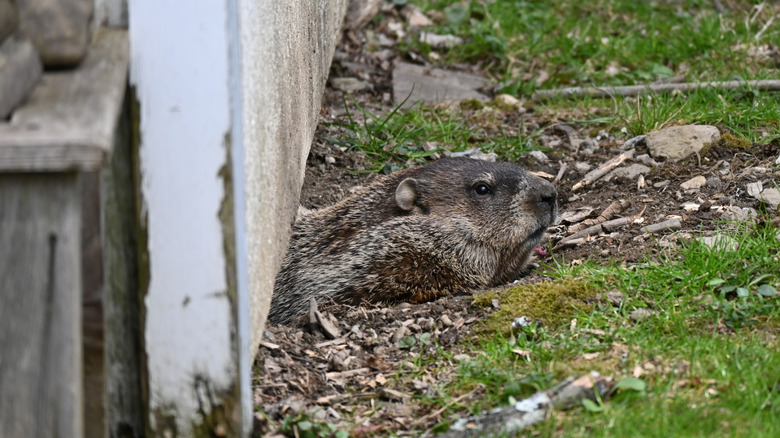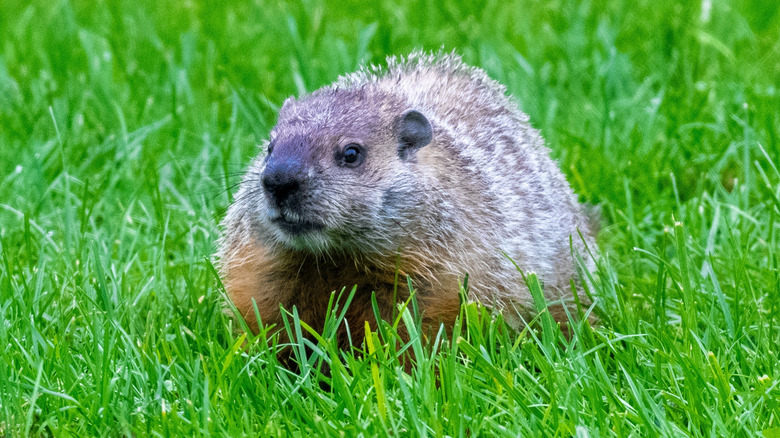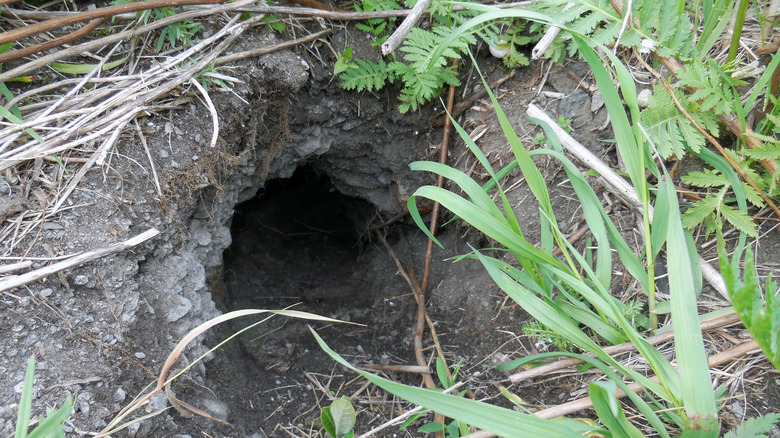Signs Groundhogs Are Camping Out Under Your Home (And What To Do About It)
How much ground could a groundhog hog, if a groundhog could hog ground? Quite a lot actually. Groundhogs (also known as woodchucks, whistlepigs, or if you attended Vassar College, "womp-womps") are cute. But besides having a particular pension for weather prediction, they can be a menace when it comes to your lawn. These oversized rodents might be digging tunnels through your grass that can leave large holes. Their extensive burrow systems will not only leave your garden in disarray, but also threaten the stability of your land and house, too. Their underground tunnels also have anywhere from two to ten entrances, so even one groundhog could leave you with a collection of holes throughout your property.
Although it's common to see groundhogs out and about — especially if your property is a hog-hotbed — there are ways to determine whether it's actually groundhogs you are dealing with or another burrowing rodent like a mole. Groundhogs will leave behind some obvious signs of digging. This can include holes and piles of dirt around your home, as well as damage to crops and ornamental plants due to marking territory and snacking. In addition, if you have a garage, shed, or porch attached to your home, look for signs of digging around there first. You may also hear high-pitched whistling noises, which is how they communicate.
Though not quite as aggressive of a chewer as beavers, they can do some damage with their teeth; not only underneath your home, but also wooden stairs, tiles, and more. If you see signs of a groundhog, you'll definitely want to deal with the problem sooner rather than later.
How groundhogs become the worst tenants on your property
Groundhogs may be relatively small, but even one can do some serious damage to your yard and garden. They leave burrow holes anywhere from 10 to 12 inches wide, which are large enough to cause you to trip or even break an ankle, but can also cause the ground to become unstable. This can lead to issues with water drainage and soil erosion, and even cause areas of your lawn to sink. While the damage to plants, grass, and the ground are annoying at best, the serious and seriously expensive damage comes when the groundhogs get a little too close to home.
These critters are not only capable of burrowing under the ground, but also under and even through structures, which can cause sinking, cracking, and erosion of the foundation. While the main concern is the digging, groundhogs are also aggressive chewers and can actually end up chewing through foundations, wires, and irrigation systems. At this point, it's not just the groundhogs you need to worry about, but rats and other rodents as well. These tunnel systems attract other small animals, and make it easier for other vermin to enter and infest your home — even if they weren't the ones to do the work to get there. The issue is that if you aren't careful, they can be easy to miss. Before you know it, you will not only have to bill an exterminator, but a contractor as well.
Keeping groundhogs (and their shadows) away
If you are currently groundhog-free and looking to stay that way, there are a couple of things you can do to keep them from moving in under your house. One of the biggest draws for groundhogs is heavy vegetation. Keep tall grasses, weeds, and overgrown shrubs to a minimum and ideally far from your home. Groundhogs often seek out this type of environment as they are able to hide safely in the cover, as well as enjoying a meal of dandelions and clover.
Groundhogs are particularly sensitive to smells, so hair clippings, predator urine, or herbs and essential oils such as rosemary, garlic, thyme, mint, lavender, oregano, and chives are great options to create a homemade groundhog repellent. There are also some pre-made repellents out there like Repels-All, which will not only keep groundhogs at bay, but the rest of their forest friends as well. Although fences may not seem useful, you can insert them at a right angle around your yard, which will protect it from the sides and the bottom.
If you have a particularly stubborn rodent resident — or a small community — you may want to trap and remove them yourself, or call a professional wildlife handler to get rid of your groundhogs. This is the most humane solution as they will then be released in a more suitable environment. If you decide to go the trap-and-release route yourself, do your research first, as it is illegal in some states. If you are cleared to do some DIY animal control, invest in a Havahart Trap that is both humane and safe for you and Punxsutawney Phil alike.


